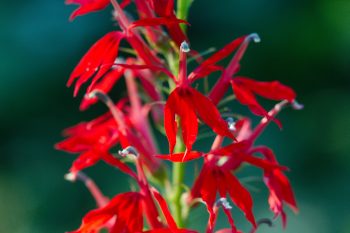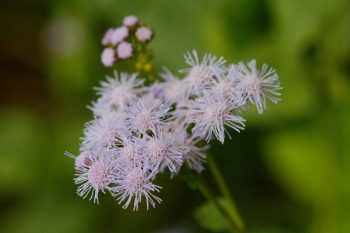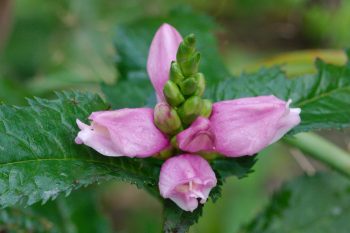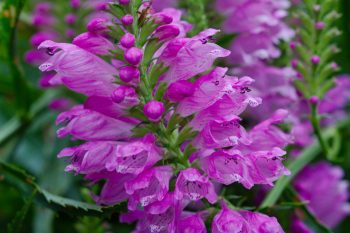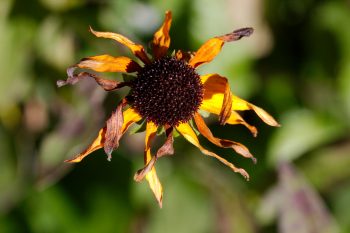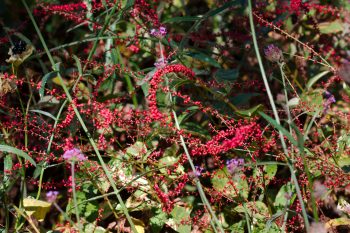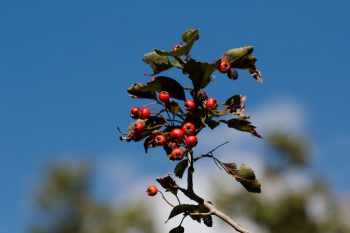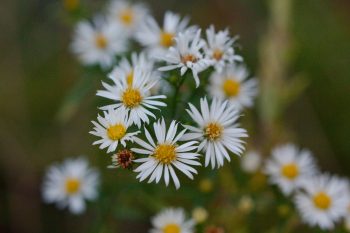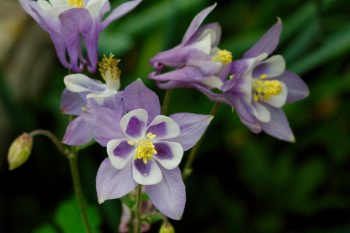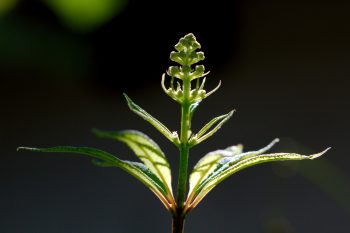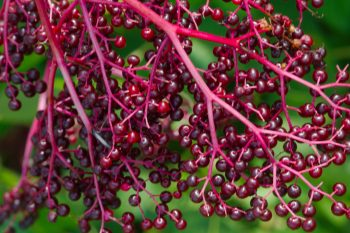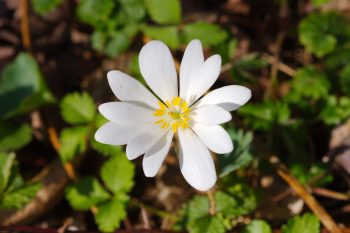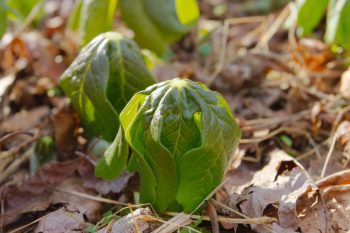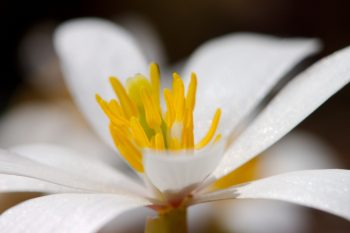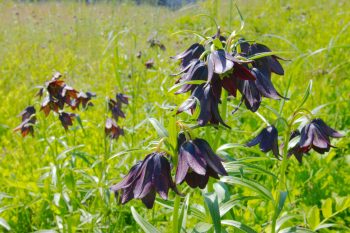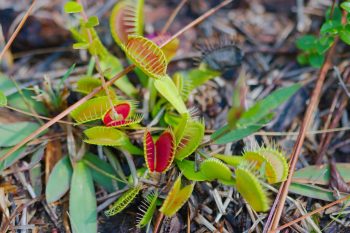There’s a lot in bloom right now, but there’s actually less variety than there was earlier in the year. The garden is full of black-eyed Susan and there are other, less showy flowers, like the mountain mint, which attracts so many pollinators. Around on the side of the house, in the shadier part of the garden, we have this cardinal flower (Lobelia cardinalis), which is absolutely stunning. The red is so pure and bright, especially when the sun is on it. Cathy saw a hummingbird come to this, as well, which is exciting. I suppose I should have posted a photo of the two of us, for our anniversary, but flowers are where it’s at.
Tagged With: Native Plants
Cardinal Flower (Lobelia cardinalis)
Conoclinium coelestinum (Blue Mistflower)
We picked up some blue mistflower (Conoclinium coelestinum) along with some other plants that were being given to us. It’s spread around the yard and now we have both the normal pale blue, as seen here (it’s more blue than this photo makes it look) and a white sport (or perhaps the blue is the sport). It blooms late in the summer, just starting now, and will be around into the fall. I don’t know that I’d run out an buy any, but it’s not bad to have a late summer bloomer in the garden. The skippers tend to be the most common pollinators on it, but the bees go to it some, too.
Chelone lyonii (Pink Turtlehead)
We’ve only had this native perennial a few years and this is by far the best it’s done in our garden. We have it in a somewhat shady area. Over time it should spread and form a clump, although not so much that it could be considered invasive (like much of what we have). The snapdragon-like flowers are fairly large and as you can see, they are borne in tight, spike-like terminal racemes. They are actually native to a bit further south than we are but have become naturalized over much of the east coast.
Physostegia virginiana
We have a patch of Physostegia virginiana (obedient plant) in the back border. This area of the garden was one of the worst in terms of being out of control and we did a lot of digging there this year. Cathy did most of it, although I did help a bit with some of the deeper digging. It was overrun with goldenrod (Solidago) and mugwort (Artemisia vulgaris), which we wanted to get rid of completely, but even the things we grew on purpose, like the Monarda and this Physostegia, were out of control and needed to be thinned out. So, we still have this, but less than we did. It’s a fairly aggressive perennial, spreading by both rhizomes and by self-seeding. So, grow with caution.
Ageratina altissima (White Snakeroot)
This is a weed and we pull it up but it’s actually fairly attractive. It’s called white snakeroot (Ageratina altissima) and it’s a fairly common native plant in our area. It’s similar to the blue mistflower (Conoclinium coelestinum) that we have in some of our borders but quite a bit taller (it’s three or four feet tall, compared to about about a foot and a half). This one is behind some shrubs so managed to get pretty much full grown before I noticed it. It will be gone shortly but I thought I’d take some pictures, anyway.
Rudbekia
The black-eyed Susans in our yard are mostly done. There is a bit of yellow left in spots but for the most part, the petals (technically they are ‘ray flowers’) are brown or at least a deeper, burnt orange color, or have fallen off completely. We generally leave the seed heads for the birds. The gold finches, in particular, seem to like them. I personally like the colors of the fading blooms. Naturally the bright, orange or mid-summer is really impressive, especially with them in such numbers. But the more subdued colors of fall are, to me, more appealing.
Persicaria virginiana ‘Painter’s Palette’
I don’t really recommend growing painter’s palette (Persicaria virginiana) unless you have a lot of space and want a natural garden. It has a tendency to spread and is a bit of work to control. We have more than we need and most of the year I’m just about ready to pull it up. This is the time of year I don’t mind it quite so much. There isn’t a lot else in bloom and it provides some color in the border with it’s tiny, red flowers on wispy stalks. We have a lot of it mixed with Verbena bonariensis in the large, central bed in our front garden and the two of them together are pretty nice. The foliage is also interesting, with green alternating with a very pale green and with a reddish, V shape stripe.
Hawthorn Berries
Twice in the last couple weeks I’ve gone out to take pictures of these hawthorn berries only to be distracted by a butterfly on the nearby Verbena. Today there were no butterflies, so today’s berry photo will make it onto the blog. This is a variety green hawthorn, Crataegus viridis ‘Winter King’. The green hawthorn is native to the southeastern United States. Although ‘Winter King’ is a more disease-resistant cultivar it still has issues with rust and some of the berries were ruined by that. I have some fungicide that I use on my two dwarf apple trees and next year I’ll probably spray this tree, as well.
Fleabane (Erigeron)
Cathy and I took a short walk in the park this afternoon. It’s been cool and damp and it was very pleasant in the woods. I took a few photos, as usual, but nothing particularly spectacular (also as usual). This is a fleabane (Erigeron) of some sort, and pretty common around here. It’s one of the few things still blooming. There were berries on the Amur honeysuckle (Lonicera maackii) as well as on the ornamental pears. When the Bradford pear was first introduced, it didn’t bear fruit because it had no other variety to pollinate its flowers. Over time, there was either enough variation in the genetic makeup or some trees were sold as Bradford that were not. Now they all bear small, round pears.
Columbine
This columbine (Aquilegia) is growing in a container just outside our front door. It’s a almost certainly a hybrid of some sort but I really don’t know anything about its parentage. It’s a pretty, pale purple color that looks especially nice in the shade. The purple goes very well with the bright yellow centers. Any time you can combine purple and yellow, it’s a winner. These are very hardy plants and grow in relatively poor conditions, which makes the ideal for a garden, especially in a shady spot.
‘Tulip’ Flower
Another from today. After we left the peony garden, Cathy and I drove around in the park and took another walk down by the lake. The tulip trees (Liriodendron tulipifera, also known as yellow poplars) are in bloom and their flowers, while not as showy as some, are still quite pretty when seen in good light. The trees are quite large, commonly reaching 60 to 90 feet, and the flowers are often not easily seen from the ground. This one was situated well and I was able to get a good photo of it. They really are quite pretty and you can see why it’s called a tulip tree.
Eutrochium purpureum (Joe Pye Weed)
I stopped at the Croyden Creek Nature Center on the way home, figuring there might be something to photograph there. The swamp milkweed (Asclepias incarnata) was just starting to bloom and I took a few pictures of that with bees on it. Around the other side of the nature center there was some Joe Pye weed (Eutrochium purpureum) coming up. It’s a native, herbaceous perennial and I find it sort of humorous that garden centers actually are able to sell it, since it grows wild around here. I don’t know who Joe Pye was but I’ve seen one story that he was a Native American medicine man who used the plant for various treatments. Anyway, I was attracted to the symmetry of the leaves and the way the light was shining on them at the top of the stem.
American Black Elderberry (Sambucus canadensis)
From Sunflower Field #4 we went to the parking area for field #1. There are no sunflowers there, but close to the parking area are two shallow, artificial ponds. We walked about half way around one of them and enjoyed the diversity of plant and animal life. We mostly saw insects and a few birds in terms of fauna. Early afternoon, in the heat of the August sun is not the best time for wildlife viewing. But the mallows (probably Hibiscus moscheutos), cardinal flower (Lobelia cardinalis) and especially the American black elderberry (Sambucus canadensis) were really nice. this is the fruit of the elderberry, ripe and ready to eat.
Sanguinaria canadensis (Bloodroot)
We went for a walk near Rock Creek today and enjoyed the spring flowers. The spring beauties (Claytonia virginica) which are in great profusion. We also saw a few bloodroot (Sanguinaria canadensis) as seen here. The flower petals are the purest white with bright yellow stamens. Although they don’t last long, they are quite lovely for the little time they are blooming each spring. The roots have a red sap, which is where they get both their common name and their genus name. The leaves are palmate and deeply-scalloped and attractive in their own right.
Podophyllum peltatum (Mayapple)
We walked in Meadowside Nature Center this afternoon and saw more bloodroot (Sanguinaria canadensis) as seen in yesterday’s photo. We also saw quite a few mayapples (Podophyllum peltatum) coming up. They come out of the ground as cones and then the leaves spread like an opening umbrella. Apparently plants with a single leaf will not flower but those with two will produce a flower stem from the leaf axil (where the two leaf stems branch). While the leaves and roots are poisonous, the fruit, when ripe, can be made into preserves and jellies. I never have, though.
Rhododendron periclymenoides (Pinxsterbloom Azalea)
After work Cathy and I went for a walk on the northwest branch of Rock Creek. The wild pinxsterbloom azaleas (Rhododendron periclymenoides) are in bloom. That’s what’s shown here. Unlike the Glenn Dale hybrid azaleas, which is what most people think of in terms of Azaleas, at least in our area, none of our native azaleas are evergreen. The flowers are also a bit different, but that’s not a bad thing, either. I think native as well as other non-evergreen azaleas should be used more than they are. I’ve got two Exbury azaleas and if I had more space, I’d have more.
Sanguinaria canadensis (Bloodroot)
Cathy and I were out in Poolesville today, to drop something off for someone. After that we decided to see if the bluebells have started blooming along Seneca Creek. It is definitely a bit early for the full show, but there was enough to see that we were glad we went. In addition to bluebells, which I’d say were somewhere around 5% open, there were trout lilies (Erythronium americanum), spring beauties (Claytonia virginica), and possibly my favorite spring ephemeral, bloodroot (Sanguinaria canadensis). They bloom very briefly and the flowers are very delicate, so seeing them at their peak is a real treat. Outside their short blooming period they are easily identified by their deeply-scalloped, palmate leaves, but you have to keep your eyes open, because they aren’t very flashy. The flowers are pure white, as you can see here, with beautiful, yellow stamens.
Chocolate Lily (Fritillaria camschatcensis)
We came to Juneau expecting rain. The weather for the last few weeks has been rain for about six days out of every seven. We woke up this morning to a clear, blue sky. After breakfast, we headed out with Brian, Lisa, and the dogs to the airport flats. This is the delta of the Mendenhall River, which has basically silted up most of the channel separating Douglas Island from the mainland. There is still a small channel that’s still got water in it, even at low tide, although an annual ‘Mud Run’ crosses the channel, so it’s not terribly deep. The flats are a good place to walk the dogs and we enjoyed being out. I got a nice photo of a savannah sparrow (Passerculus sandwichensis) and we saw lots of lupine as well as many chocolate lilies (Fritillaria camschatcensis). They are pretty, in a brown sort of way, although I can’t recommend their fragrance, in particular. They are native to eastern Asia, Alaska, Yukon Territory, British Columbia and the far northwestern contiguous United States.
Dionaea muscipula (Venus Flytrap)
A few of us went to the Green Swamp this morning. As usual, the humidity was a bit oppressive but it was actually cooler than it’s been most years and it wasn’t until we were nearly back to the car that I was starting to feel particularly uncomfortable. The trail goes through long-leaf pine savanna for the most part, but areas of that are separated by pocosins (evergreen shrub bogs). In the past there have been boardwalks through those but this year they were gone. I found out later that the preserve was technically closed, although there were no signs to that effect anywhere that we saw. The reason was that the boardwalks were out, having been destroyed in a wildfire. We managed to get through them and found four of the 14 carnivorous plants known to grow in the swamp. The four we saw were the Venux flytrap (Dionaea muscipula) shown here, along with a few sundews (Drosery species), yellow pitcher plant (Sarracenia flava), and purple pitcher plants (Sarracenia purpurea subsp. venosa). All in all, I’d say it was a successful outing.

